Wei-Cheng Tseng
Probing the Robustness Properties of Neural Speech Codecs
May 30, 2025Abstract:Neural speech codecs have revolutionized speech coding, achieving higher compression while preserving audio fidelity. Beyond compression, they have emerged as tokenization strategies, enabling language modeling on speech and driving paradigm shifts across various speech processing tasks. Despite these advancements, their robustness in noisy environments remains underexplored, raising concerns about their generalization to real-world scenarios. In this work, we systematically evaluate neural speech codecs under various noise conditions, revealing non-trivial differences in their robustness. We further examine their linearity properties, uncovering non-linear distortions which partly explain observed variations in robustness. Lastly, we analyze their frequency response to identify factors affecting audio fidelity. Our findings provide critical insights into codec behavior and future codec design, as well as emphasizing the importance of noise robustness for their real-world integration.
Cosmos World Foundation Model Platform for Physical AI
Jan 07, 2025



Abstract:Physical AI needs to be trained digitally first. It needs a digital twin of itself, the policy model, and a digital twin of the world, the world model. In this paper, we present the Cosmos World Foundation Model Platform to help developers build customized world models for their Physical AI setups. We position a world foundation model as a general-purpose world model that can be fine-tuned into customized world models for downstream applications. Our platform covers a video curation pipeline, pre-trained world foundation models, examples of post-training of pre-trained world foundation models, and video tokenizers. To help Physical AI builders solve the most critical problems of our society, we make our platform open-source and our models open-weight with permissive licenses available via https://github.com/NVIDIA/Cosmos.
Dynamic-SUPERB Phase-2: A Collaboratively Expanding Benchmark for Measuring the Capabilities of Spoken Language Models with 180 Tasks
Nov 08, 2024



Abstract:Multimodal foundation models, such as Gemini and ChatGPT, have revolutionized human-machine interactions by seamlessly integrating various forms of data. Developing a universal spoken language model that comprehends a wide range of natural language instructions is critical for bridging communication gaps and facilitating more intuitive interactions. However, the absence of a comprehensive evaluation benchmark poses a significant challenge. We present Dynamic-SUPERB Phase-2, an open and evolving benchmark for the comprehensive evaluation of instruction-based universal speech models. Building upon the first generation, this second version incorporates 125 new tasks contributed collaboratively by the global research community, expanding the benchmark to a total of 180 tasks, making it the largest benchmark for speech and audio evaluation. While the first generation of Dynamic-SUPERB was limited to classification tasks, Dynamic-SUPERB Phase-2 broadens its evaluation capabilities by introducing a wide array of novel and diverse tasks, including regression and sequence generation, across speech, music, and environmental audio. Evaluation results indicate that none of the models performed well universally. SALMONN-13B excelled in English ASR, while WavLLM demonstrated high accuracy in emotion recognition, but current models still require further innovations to handle a broader range of tasks. We will soon open-source all task data and the evaluation pipeline.
Gaussian Splatting Visual MPC for Granular Media Manipulation
Oct 13, 2024



Abstract:Recent advancements in learned 3D representations have enabled significant progress in solving complex robotic manipulation tasks, particularly for rigid-body objects. However, manipulating granular materials such as beans, nuts, and rice, remains challenging due to the intricate physics of particle interactions, high-dimensional and partially observable state, inability to visually track individual particles in a pile, and the computational demands of accurate dynamics prediction. Current deep latent dynamics models often struggle to generalize in granular material manipulation due to a lack of inductive biases. In this work, we propose a novel approach that learns a visual dynamics model over Gaussian splatting representations of scenes and leverages this model for manipulating granular media via Model-Predictive Control. Our method enables efficient optimization for complex manipulation tasks on piles of granular media. We evaluate our approach in both simulated and real-world settings, demonstrating its ability to solve unseen planning tasks and generalize to new environments in a zero-shot transfer. We also show significant prediction and manipulation performance improvements compared to existing granular media manipulation methods.
SpeechPrompt: Prompting Speech Language Models for Speech Processing Tasks
Aug 23, 2024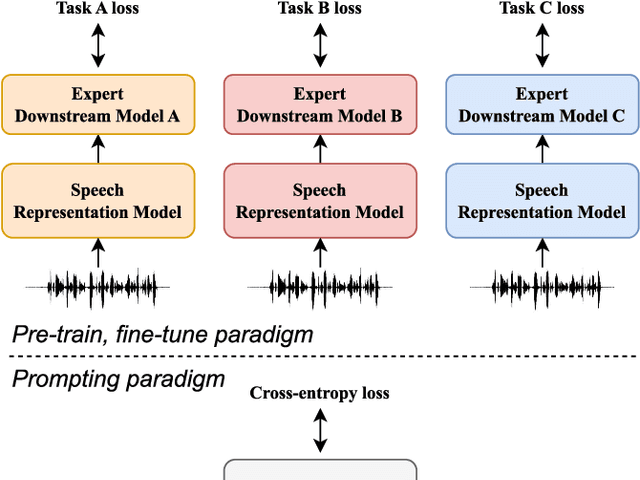
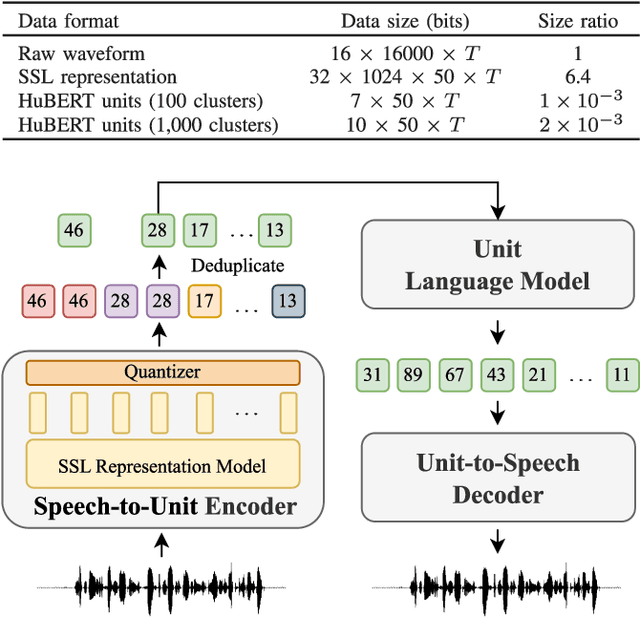
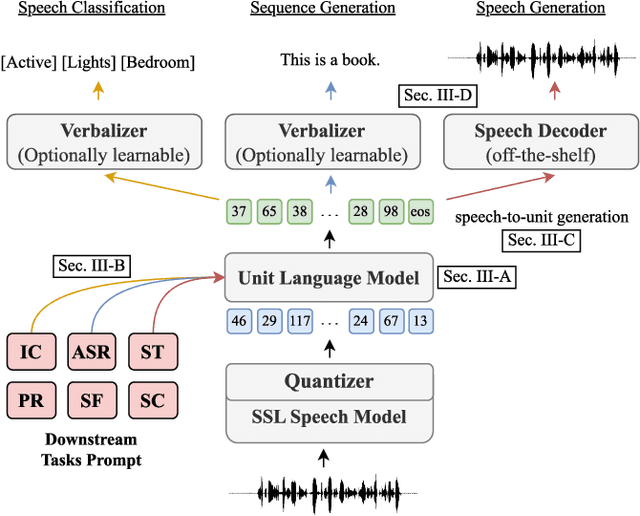

Abstract:Prompting has become a practical method for utilizing pre-trained language models (LMs). This approach offers several advantages. It allows an LM to adapt to new tasks with minimal training and parameter updates, thus achieving efficiency in both storage and computation. Additionally, prompting modifies only the LM's inputs and harnesses the generative capabilities of language models to address various downstream tasks in a unified manner. This significantly reduces the need for human labor in designing task-specific models. These advantages become even more evident as the number of tasks served by the LM scales up. Motivated by the strengths of prompting, we are the first to explore the potential of prompting speech LMs in the domain of speech processing. Recently, there has been a growing interest in converting speech into discrete units for language modeling. Our pioneer research demonstrates that these quantized speech units are highly versatile within our unified prompting framework. Not only can they serve as class labels, but they also contain rich phonetic information that can be re-synthesized back into speech signals for speech generation tasks. Specifically, we reformulate speech processing tasks into speech-to-unit generation tasks. As a result, we can seamlessly integrate tasks such as speech classification, sequence generation, and speech generation within a single, unified prompting framework. The experiment results show that the prompting method can achieve competitive performance compared to the strong fine-tuning method based on self-supervised learning models with a similar number of trainable parameters. The prompting method also shows promising results in the few-shot setting. Moreover, with the advanced speech LMs coming into the stage, the proposed prompting framework attains great potential.
* Published in IEEE/ACM Transactions on Audio, Speech, and Language Processing (TASLP)
A Large-Scale Evaluation of Speech Foundation Models
Apr 15, 2024Abstract:The foundation model paradigm leverages a shared foundation model to achieve state-of-the-art (SOTA) performance for various tasks, requiring minimal downstream-specific modeling and data annotation. This approach has proven crucial in the field of Natural Language Processing (NLP). However, the speech processing community lacks a similar setup to explore the paradigm systematically. In this work, we establish the Speech processing Universal PERformance Benchmark (SUPERB) to study the effectiveness of the paradigm for speech. We propose a unified multi-tasking framework to address speech processing tasks in SUPERB using a frozen foundation model followed by task-specialized, lightweight prediction heads. Combining our results with community submissions, we verify that the foundation model paradigm is promising for speech, and our multi-tasking framework is simple yet effective, as the best-performing foundation model shows competitive generalizability across most SUPERB tasks. For reproducibility and extensibility, we have developed a long-term maintained platform that enables deterministic benchmarking, allows for result sharing via an online leaderboard, and promotes collaboration through a community-driven benchmark database to support new development cycles. Finally, we conduct a series of analyses to offer an in-depth understanding of SUPERB and speech foundation models, including information flows across tasks inside the models, the correctness of the weighted-sum benchmarking protocol and the statistical significance and robustness of the benchmark.
VMCML: Video and Music Matching via Cross-Modality Lifting
Mar 22, 2023Abstract:We propose a content-based system for matching video and background music. The system aims to address the challenges in music recommendation for new users or new music give short-form videos. To this end, we propose a cross-modal framework VMCML that finds a shared embedding space between video and music representations. To ensure the embedding space can be effectively shared by both representations, we leverage CosFace loss based on margin-based cosine similarity loss. Furthermore, we establish a large-scale dataset called MSVD, in which we provide 390 individual music and the corresponding matched 150,000 videos. We conduct extensive experiments on Youtube-8M and our MSVD datasets. Our quantitative and qualitative results demonstrate the effectiveness of our proposed framework and achieve state-of-the-art video and music matching performance.
SpeechPrompt v2: Prompt Tuning for Speech Classification Tasks
Mar 01, 2023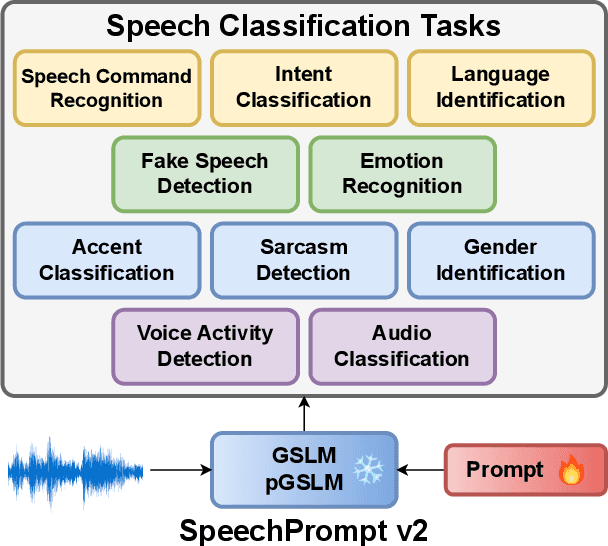
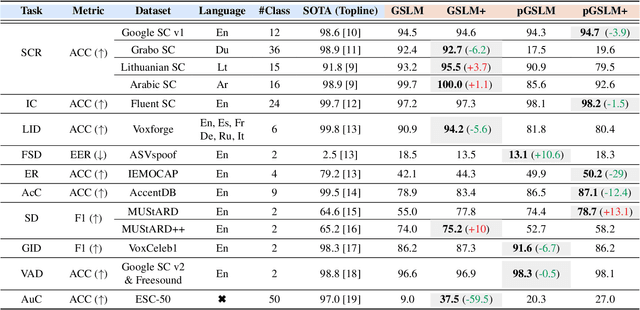
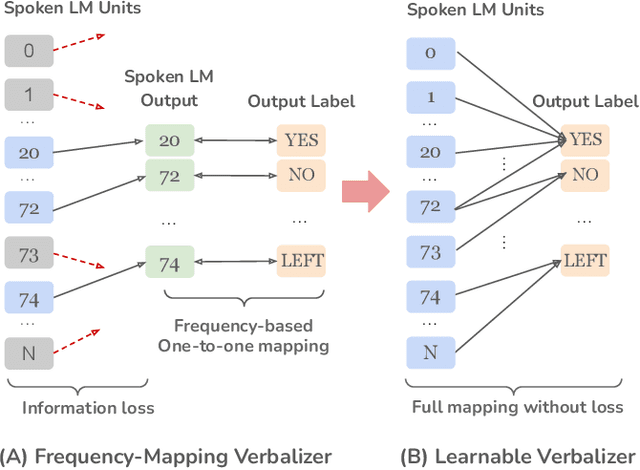
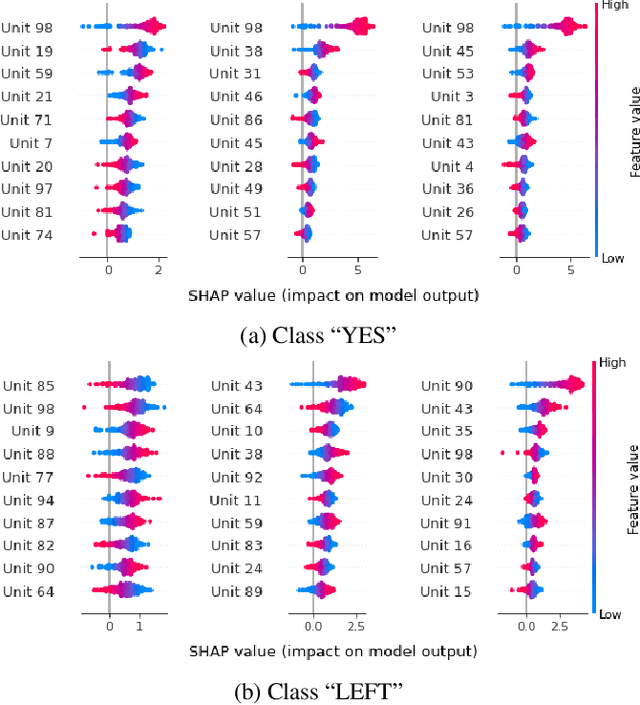
Abstract:Prompt tuning is a technology that tunes a small set of parameters to steer a pre-trained language model (LM) to directly generate the output for downstream tasks. Recently, prompt tuning has demonstrated its storage and computation efficiency in both natural language processing (NLP) and speech processing fields. These advantages have also revealed prompt tuning as a candidate approach to serving pre-trained LM for multiple tasks in a unified manner. For speech processing, SpeechPrompt shows its high parameter efficiency and competitive performance on a few speech classification tasks. However, whether SpeechPrompt is capable of serving a large number of tasks is unanswered. In this work, we propose SpeechPrompt v2, a prompt tuning framework capable of performing a wide variety of speech classification tasks, covering multiple languages and prosody-related tasks. The experiment result shows that SpeechPrompt v2 achieves performance on par with prior works with less than 0.15M trainable parameters in a unified framework.
Ensemble knowledge distillation of self-supervised speech models
Feb 24, 2023Abstract:Distilled self-supervised models have shown competitive performance and efficiency in recent years. However, there is a lack of experience in jointly distilling multiple self-supervised speech models. In our work, we performed Ensemble Knowledge Distillation (EKD) on various self-supervised speech models such as HuBERT, RobustHuBERT, and WavLM. We tried two different aggregation techniques, layerwise-average and layerwise-concatenation, to the representations of different teacher models and found that the former was more effective. On top of that, we proposed a multiple prediction head method for student models to predict different layer outputs of multiple teacher models simultaneously. The experimental results show that our method improves the performance of the distilled models on four downstream speech processing tasks, Phoneme Recognition, Speaker Identification, Emotion Recognition, and Automatic Speech Recognition in the hidden-set track of the SUPERB benchmark.
DDOS: A MOS Prediction Framework utilizing Domain Adaptive Pre-training and Distribution of Opinion Scores
Apr 07, 2022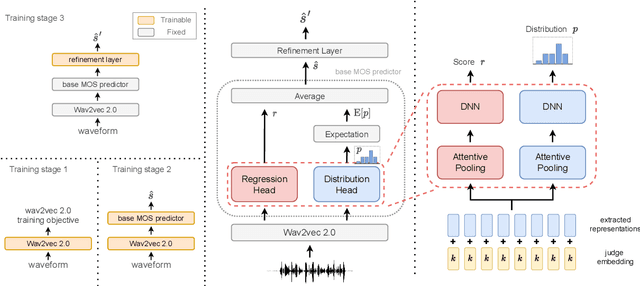
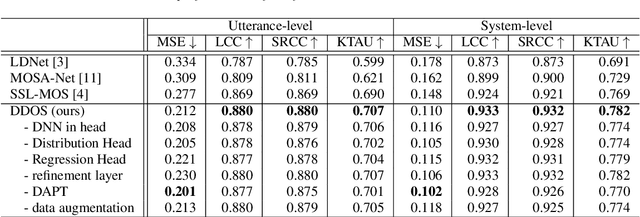

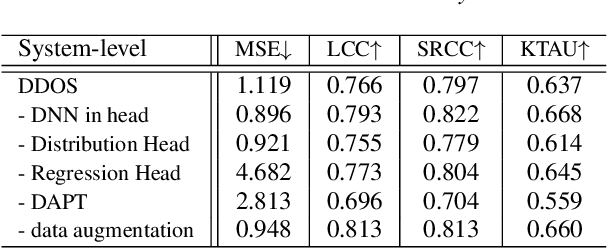
Abstract:Mean opinion score (MOS) is a typical subjective evaluation metric for speech synthesis systems. Since collecting MOS is time-consuming, it would be desirable if there are accurate MOS prediction models for automatic evaluation. In this work, we propose DDOS, a novel MOS prediction model. DDOS utilizes domain adaptive pre-training to further pre-train self-supervised learning models on synthetic speech. And a proposed module is added to model the opinion score distribution of each utterance. With the proposed components, DDOS outperforms previous works on BVCC dataset. And the zero shot transfer result on BC2019 dataset is significantly improved. DDOS also wins second place in Interspeech 2022 VoiceMOS challenge in terms of system-level score.
 Add to Chrome
Add to Chrome Add to Firefox
Add to Firefox Add to Edge
Add to Edge